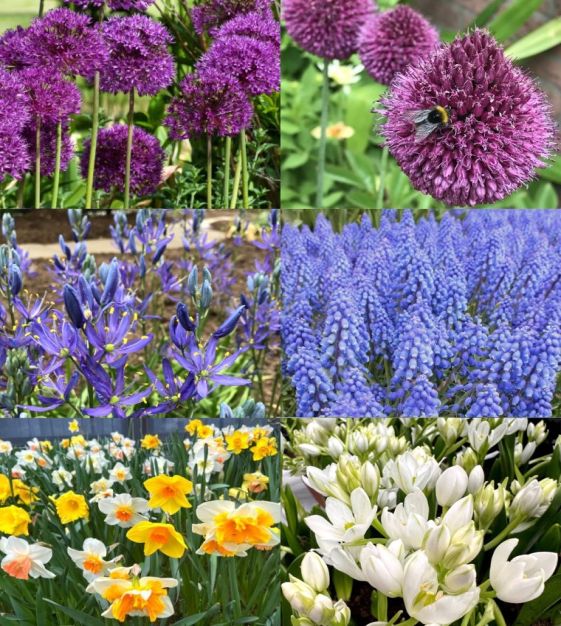-
- Discounted Collections
- Website Specials
- New for 2025!
- Tulips
- Narcissi
- Allium
- Anemone blanda
- Brodiaea
- Camassia
- Chionodoxa
- Corydalis
- Crocus
- Eranthis
- Eremurus
- Erythronium
- Fritillaria
- Galanthus
- Geranium
- Gladiolus
- Hyacinths
- Hyacinthoides
- Ipheion uniflorum
- Dutch Iris
- Rock Garden Iris
- Ixiolirion
- Leucojum aestivum
- Muscari
- Ornithogalum
- Oxalis
- Puschkinia
- Scilla
- Lilies
- Peonies
- Amaryllis
- Paperwhites
- Tender Bulbs
- Anemone Giants
- Tecolote Ranunculus
- Freesias
Collection P: The Deer-Proof Garden
As much as we love wildlife, we hate to see deer grazing in our gardens. Flower bulbs that are not normally deer bon-bons include: Allium, Anemone blanda, Camassia, Chionodoxa, Corydalis, Crocus, Dutch Iris, Eranthis hyemalis, Erythronium, Fritillaria, Geranium tuberosum, Galanthus, Hyacinthoides, Hyacinths, Ipheion, Ixiolirion, Leucojum, Muscari, Narcissi, Ornithogalum, Oxalis, Puschkinia and Scilla. Our fragrant, bareroot Herbacecous Peonies are not eaten by deer either. Estimated planting area: 40 square feet. Top size bulbs. Bloom time: April-July. Plant the smaller bulbs about 5" deep and 5" apart; plant the Narcissi 6" to 8" deep and 6" apart and plant the big Allium bulbs 6" to 8" deep. Horticultural zones: 4-7. Height: 5" to 24". Please note that our collections are shipped in mid-October.
(Please note that due to state agricultural restrictions, we are not permitted to ship Allium bulbs to Idaho, Oregon or the following 5 counties in the state of Washington: Adams, Benton, Franklin, Grant and Klickitat.) (Each variety's photo appears in order as listed from left to right and top to bottom.)
• 50 Allium aflatunense Purple Sensation: Violet purple. 24" to 30".
• 50 Allium sphaerocephalon: The Drumstick Allium. Dark crimson-purple. 24".
• 50 Camassia quamash: Pale to deep lavender-blue. 15".
• 50 Muscari armeniacum: The Blue Grape Hyacinth. Electric cobalt-blue. 6".
• 50 Narcissus Grand Mixture: White, yellow and bicolor. 18" to 20".
• 50 Ornithogalum balansae: White star shaped flowers. 5".
- Information
Allium
Latin for garlic, the Flowering Onions are available in diverse heights and sizes, are rabbit-, rodent- and deer-resistant, and are seldom affected by disease. Adored by bees, butterflies and pollinators, Allium extend the spring flowering season with bold, dramatic color and statuesque garden architecture. They are also valuable cut and dried flowers.
Allium require full sunlight although there are several varieties that can also thrive in partial sunlight: A. cowanii and siculum bulgaricum. Allium require rich, well-draining and neutral pH soil and benefit from a summer dry period. A. triquetrum can handle soil with a bit more moisture in it (but never standing water). All Allium must be planted outdoors in the fall after the soil has cooled down to around 55°F (normally after two weeks of night time temperatures hovering around 40°F). While most Allium are not recommended for forcing over the winter, there are several varieties that are known to be good forcers: A. cowanii and karataviense. Please note that flower size is presented as the width, or diameter, from left to right.
Plant the larger Allium bulbs 6" to 8" deep and 8" to 10" apart. Plant the smaller Allium bulbs 4" deep and 3" to 4" apart. Top size bulbs. Bloom time: May through August depending on the variety. Height: variable depending on the variety. Variable horticultural zones ranging from 3-10 depending on the variety.
We’re very sorry, but due to state agricultural restrictions, we are not permitted to ship Allium bulbs to Idaho or Oregon, or the following five counties in the State of Washington: Adams, Benton, Franklin, Grant and Klickitat.
Allium are The Art & Soul of Spring and Summer.
Allium Horticultural Tips
Allium
Latin for garlic, the Flowering Onions are available in diverse heights and sizes, are rabbit-, rodent- and deer-resistant, and are seldom affected by disease. Adored by bees, butterflies and pollinators, Allium extend the spring flowering season with bold, dramatic color and statuesque garden architecture. They are also valuable cut and dried flowers.
Allium require full sunlight although there are several varieties that can also thrive in partial sunlight: A. cowanii and siculum bulgaricum. Allium require rich, well-draining and neutral pH soil and benefit from a summer dry period. A. triquetrum can handle soil with a bit more moisture in it (but never standing water). All Allium must be planted outdoors in the fall after the soil has cooled down to around 55°F (normally after two weeks of night time temperatures hovering around 40°F). While most Allium are not recommended for forcing over the winter, there are several varieties that are known to be good forcers: A. cowanii and karataviense. Please note that flower size is presented as the width, or diameter, from left to right.
Plant the larger Allium bulbs 6" to 8" deep and 8" to 10" apart. Plant the smaller Allium bulbs 4" deep and 3" to 4" apart. Top size bulbs. Bloom time: May through August depending on the variety. Height: variable depending on the variety. Variable horticultural zones ranging from 3-10 depending on the variety.
We’re very sorry, but due to state agricultural restrictions, we are not permitted to ship Allium bulbs to Idaho or Oregon, or the following five counties in the State of Washington: Adams, Benton, Franklin, Grant and Klickitat.
Allium are The Art & Soul of Spring and Summer.
Allium Horticultural Tips





